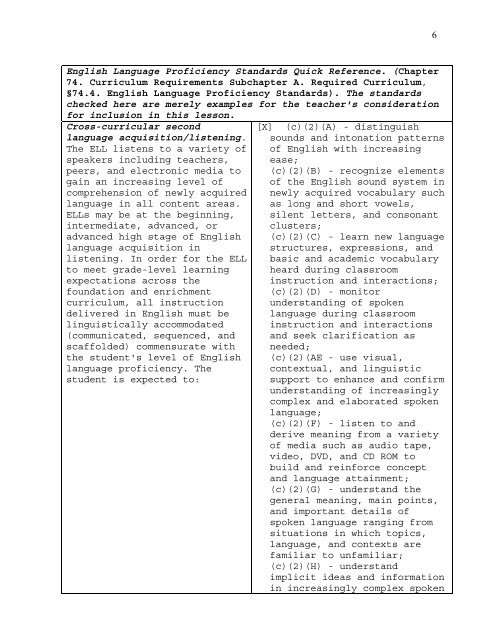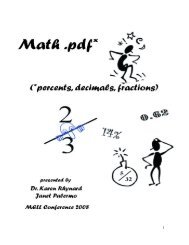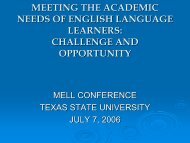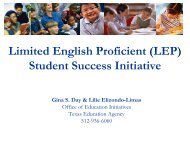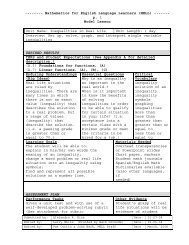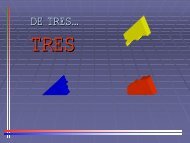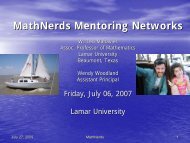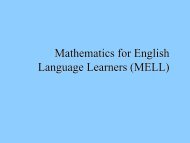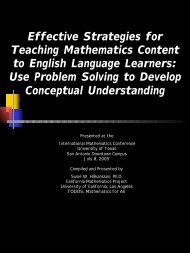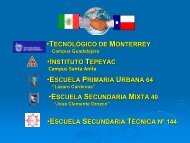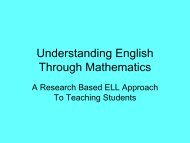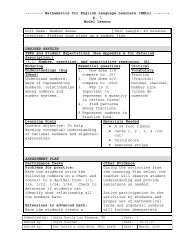Geometric patterns - Mathematics for English Language Learners ...
Geometric patterns - Mathematics for English Language Learners ...
Geometric patterns - Mathematics for English Language Learners ...
You also want an ePaper? Increase the reach of your titles
YUMPU automatically turns print PDFs into web optimized ePapers that Google loves.
6<br />
<strong>English</strong> <strong>Language</strong> Proficiency Standards Quick Reference. (Chapter<br />
74. Curriculum Requirements Subchapter A. Required Curriculum,<br />
§74.4. <strong>English</strong> <strong>Language</strong> Proficiency Standards). The standards<br />
checked here are merely examples <strong>for</strong> the teacher's consideration<br />
<strong>for</strong> inclusion in this lesson.<br />
Cross-curricular second<br />
language acquisition/listening.<br />
The ELL listens to a variety of<br />
speakers including teachers,<br />
peers, and electronic media to<br />
gain an increasing level of<br />
comprehension of newly acquired<br />
language in all content areas.<br />
ELLs may be at the beginning,<br />
intermediate, advanced, or<br />
advanced high stage of <strong>English</strong><br />
language acquisition in<br />
listening. In order <strong>for</strong> the ELL<br />
to meet grade-level learning<br />
expectations across the<br />
foundation and enrichment<br />
curriculum, all instruction<br />
delivered in <strong>English</strong> must be<br />
linguistically accommodated<br />
(communicated, sequenced, and<br />
scaffolded) commensurate with<br />
the student's level of <strong>English</strong><br />
language proficiency. The<br />
student is expected to:<br />
[X] (c)(2)(A) - distinguish<br />
sounds and intonation <strong>patterns</strong><br />
of <strong>English</strong> with increasing<br />
ease;<br />
(c)(2)(B) - recognize elements<br />
of the <strong>English</strong> sound system in<br />
newly acquired vocabulary such<br />
as long and short vowels,<br />
silent letters, and consonant<br />
clusters;<br />
(c)(2)(C) - learn new language<br />
structures, expressions, and<br />
basic and academic vocabulary<br />
heard during classroom<br />
instruction and interactions;<br />
(c)(2)(D) - monitor<br />
understanding of spoken<br />
language during classroom<br />
instruction and interactions<br />
and seek clarification as<br />
needed;<br />
(c)(2)(AE - use visual,<br />
contextual, and linguistic<br />
support to enhance and confirm<br />
understanding of increasingly<br />
complex and elaborated spoken<br />
language;<br />
(c)(2)(F) - listen to and<br />
derive meaning from a variety<br />
of media such as audio tape,<br />
video, DVD, and CD ROM to<br />
build and rein<strong>for</strong>ce concept<br />
and language attainment;<br />
(c)(2)(G) - understand the<br />
general meaning, main points,<br />
and important details of<br />
spoken language ranging from<br />
situations in which topics,<br />
language, and contexts are<br />
familiar to unfamiliar;<br />
(c)(2)(H) - understand<br />
implicit ideas and in<strong>for</strong>mation<br />
in increasingly complex spoken


